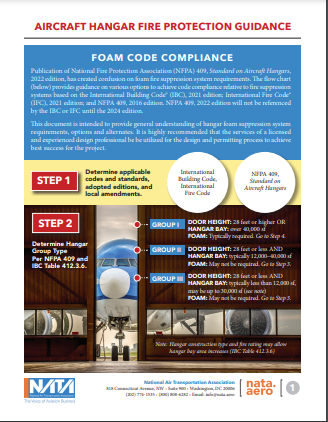NATA recently released Aircraft Hangar Fire Protection Guidance for hangar owners and operators seeking a general understanding of updated hangar foam suppression system requirements, options, and alternatives.
The guidance tool further educates members on the impact of two NATA-supported revisions to NFPA 409: Standard on Aircraft Hangars approved by the National Fire Protection Association (NFPA) Technical Committee on Airport Facilities to: (1) create a new risk-based process for determining/defining hangar fire protection requirements – applicable to both new and existing hangars, and (2) exempt Group II hangars where hazardous operations are not performed from the foam requirements within NFPA 409.
“When the 2022 edition of NFPA 409: Standard on Aircraft Hangars was released in October 2021, changes to the standard raised questions on how the new requirements would impact both existing hangars and new hangar construction,” stated NATA Managing Director of Industry & Regulatory Affairs Megan Eisenstein. “We thank Doug Fisher, Principal Fire Protection Engineer for Fisher Engineering, Inc., for his important role in the development of this comprehensive guidance.”
The guidance follows NATA and industry efforts to highlight costly risks to the environment, human health, and operational budgets associated with accidental foam system discharges. Important considerations for those with foam fire suppression systems in place or for those contemplating the need for one.
In response, Aircraft Hangar Fire Protection Guidance not only provides information on the current aircraft hangar fire protection requirements and strategies, but also recommendations to reduce the likelihood of an inadvertent foam system discharge of a new or existing system. “Importantly, this document also outlines a variety of design options and equivalency approaches that may allow for the removal of a foam fire suppression system,” Doug Fisher said.
Additionally, Fisher highlights an industry recommendation for stakeholders to utilize the services of a licensed design professional, typically a fire protection engineer or architect, to assist in discussions on the need for a foam fire suppression system with local code authorities. “Experienced design professionals are invaluable to educating local code authorities as they can help bridge the knowledge gap between the operations being performed in the hangar and the requirements for a foam fire suppression system,” he said.
The Aircraft Hangar Fire Protection Guidance can be accessed here. NATA also developed a Fire Marshal Toolkit resource that can further educate stakeholders on foam fire suppression systems. Read more about the Aircraft Hangar Foam Fire Suppression Initiative on NATA’s website.






